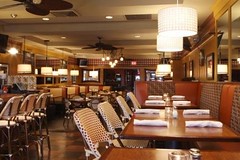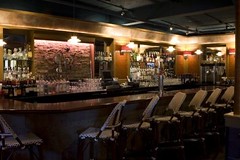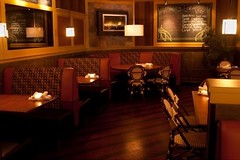65 N. Park Avenue, Rockville Centre, NY 11570
www.georgemartingroup.com 1-516-678-7272
The George Martin Restaurant Group was established in 1989, opening locations ever since. Grillfire, is a George Martin Group Restaurant that has three separate locations with an electic variety of steaks, chops, seafood, and salads & burgers.
George Martin's Grillfire (Rockville Centre, NY)
History of Rockville Centre, NY
December 13, 1643 - Sachem Tackapousha, chief of the Indians occupying the "Rockaways" and south shore of Long Island, and six other chiefs signed a deed granting Englishmen a large tract of land encompassing all the southern half of what is now Nassau County. Twelve years later, fearing that the Indians felt inadequately compensated. Governor Nichols of New York wrote the magistrates of the newly established Town of Hempstead to "pay Tackapousha further gratuities for payment of lands which he said were bought too cheap . . . and prevent trouble and settle it one and for all." In 1657 they did just that and added to the original payment "some great cattle, and some small cattle, and some wampum, and some hatchets, some knives, some trading cloth, and . . . some powder and lead, and they went away for anything I know very well satisfied." as recorded by one of the negotiators.
The growth of the region, and the importance of Rockville Centre to the area's economy is highlighted by the founding, in February 1891, of the Bank of Rockville Centre, the first commercial bank operated on Long Island's south shore. The bank occupied the corner of Merrick Road and North Village Avenue. Banking was a growth industry in the Village, and by 1929, Rockville Centre had earned a reputation as a leading financial center for the Island. Today, many banking institutions have branches in the Village.
As incorporation and self-determination of municipal services dawned, Rockville Centre was a thriving community of 2,000.
Named after its first inhabitants, the Merokee Indians, the land changed hands in 1643 when Sachem Tackapousha signed a treaty with Merrick's first colonists, English settlers who escaped the oppressive reign of King Charles I. During the colonial period, Merrick became a trading center because vessels could enter Jones Inlet and sail up deep channels to docks beside what is now Merrick Road. During the War of 1812 these channels, canals and coves made Merrick a haven for buccaneers who preyed on merchants. Pirates in whaleboats once robbed prominent landowner George Hewlett and two friends while they were duck hunting, ripping the silver buttons from their coats. At one point, residents armed with muskets captured one bandit leader and shipped him to New York in irons for trial.
Merrick as Mecca: During a surge of religious activity in the 1860s, Methodists from around the state congregated in Merrick annually. In the beginning, horses and buggies were pulled into two circles around an open field for 10 days of services. The camp normally attracted about 300 worshipers, but some meetings were attended by up to 10,000. Circular streets, such as Fletcher and Asbury Avenues, lined with small cottages that developed around the campground, remain today in the North Merrick neighborhood called the Campgrounds by residents.
Turning Points: The construction of the South Shore Rail Road, predecessor of the Long Island Rail Road, through Merrick in the late 1880s began a period of development. The boom in population and growth after World War II gradually led to Merrick and North Merrick developing distinct identities and separate school districts.
Merrick as Mecca: During a surge of religious activity in the 1860s, Methodists from around the state congregated in Merrick annually. In the beginning, horses and buggies were pulled into two circles around an open field for 10 days of services. The camp normally attracted about 300 worshipers, but some meetings were attended by up to 10,000. Circular streets, such as Fletcher and Asbury Avenues, lined with small cottages that developed around the campground, remain today in the North Merrick neighborhood called the Campgrounds by residents.
Turning Points: The construction of the South Shore Rail Road, predecessor of the Long Island Rail Road, through Merrick in the late 1880s began a period of development. The boom in population and growth after World War II gradually led to Merrick and North Merrick developing distinct identities and separate school districts.
George Martin's Grillfire (Long Beach, NY)
Long Beach is one of the older, more established communities on Long Island. Founded in 1880 when the first Long Beach Hotel was built, it continued to grow at a steady pace (the railroad arrived in 1882 promoting Long Beach as a resort community for vacationers). The major attraction in its development was the fact that Long Beach is an oceanfront island along Long Island’ s south shore which has a moderating effect on its climate. Long Beachaverages 10 degrees warmer in the winter and 10 degrees cooler in the summer than inland communities on Long Island and New York City. With the ocean on one side and the bay on the other, Long Beach developed as a seaside community.
By the beach on the oceanfront there is a 2 ¼ mile long boardwalk (built in 1914 with the help of some elephants), where, both in winter and summer, one can find strollers, joggers and bicycle riders. A section of the boardwalk is set aside as a bicycle lane and the recent interest in physical fitness has resulted in an increased use of the lighted boardwalk both during the day and at night. The adjacent beach is a 3.5 mile stretch of pure white sand open to the public year round with daily and seasonal rates during the summer (call (516) 431-3890 for information).
The City of Long Beach is one of only two cities on Long Island (the other is Glen Cove). Although geographically within the Town of Hempsteadlocated in Nassau County, Long Beach is politically independent and self-governing. The governing body consists of a five member City Council elected every two years, which appoints a City Manager. Long Beach also elects a Legislator every four years to represent the city on the six-member Nassau County’s legislative body.
The City of Long Beach currently has a population of about 35,000 persons and about 15,000 households spread across two square miles of land surrounded by water. Over 4,000 children attend Long Beachschools. Its two major downtown shopping areas along Park Avenue and along West Beech Street are a hub of activity supported by the strong Long Beach Chamber of Commerce, in existence for over six decades.
The bay side of the community is lined with homes and private docks. Waterfront homes can also be found in an area called the Canals. Man-made extensions were created when canals were dug connecting areas ofLong Beach to the bay. In fact, no home is more than a few hundred yards from the water as Long Beach is only ½ mile wide at its widest point.
In terms of housing, Long Beach offers one of the widest ranges of living styles on Long Island. New condominiums, which include all kinds of self-contained recreational facilities, are springing up along a portion of the oceanfront. New homes embodying the latest architectural designs can be seen along with the older gracious dwellings which were built in 1930. Older smaller homes are also to be found throughout the island, which once were seasonal summer homes, but now serve as year round residences.
Much of Long Beach is going through revitalization and redevelopment. Part of the down town commercial shopping area along West Park Avenue recently underwent a beautiful facelift, including restoration of the historic train station and the addition of several new shops. Long Beach is also going through somewhat of a housing boom as older buildings are being replaced or recycled into new modern residences both along the shore and throughout the inland parts of the City.
The 403 bed Long Beach Memorial Hospital, built in 1922 as a first aid station for beachgoers, recently opened a new 12,000 square foot state-of-the-art Emergency Room with cardiac care unit, trauma room, pediatric room and private observation rooms. The two-block long hospital, a voluntary not-for-profit teaching medical complex, also runs the area’s community-based ambulance service and a nursing home.




No comments:
Post a Comment